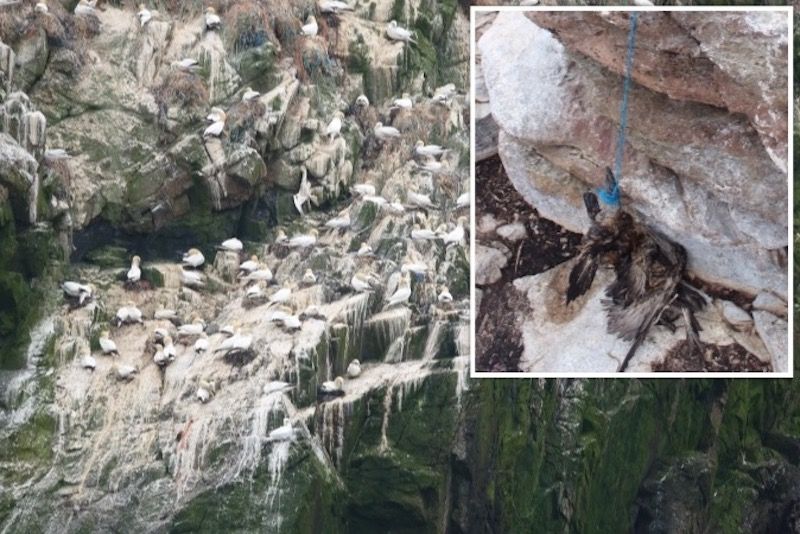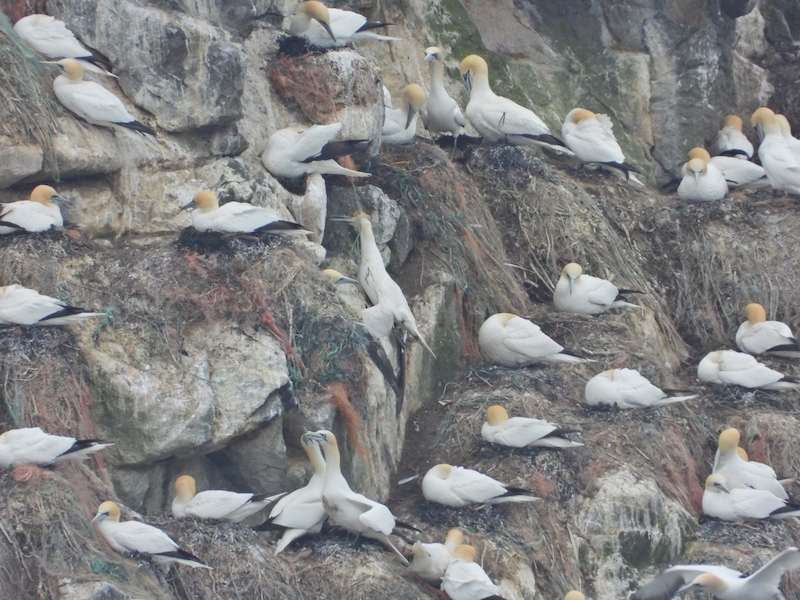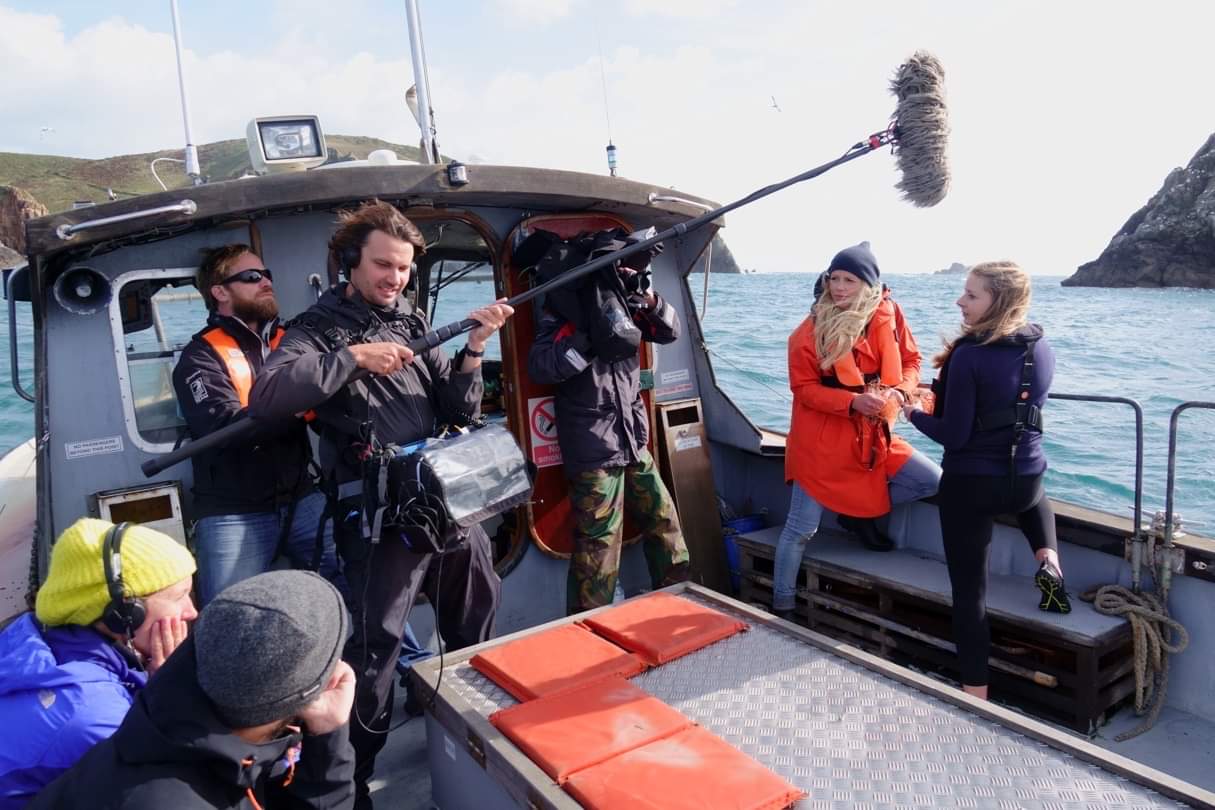

A spate of gannet deaths in what is considered one of the more rural Channel Islands has laid bare the devastating effects of plastic pollution, with new photographs showing how the material has made its way into their nests and stomachs.
Wildlife officers on Alderney have for the first time identified the number of the seabirds killed from getting entangled with during breeding season at the island's colonies.
Through photographs, ringing and tagging projects, post-death analysis and studies of the gannetry after the birds left this year, Alderney Wildlife Trust (AWT) staff were able to track those who were tangled in plastic brought back to their nests, and those that died.
At least 53 gannets were found to have become entangled with plastic, preventing them from feeding on Les Etacs and Ortac.
Meanwhile, the number of carcasses totalled 34 – but AWT wanrs this number is likely to be “the tip of the iceberg”.
Pictured: One of the birds found entangled in plastic. (Daniele Clifford)
Around 8,000 gannet pairs – 2% of the world total – make their way to Alderney's two gannet colonies to breed each year.
In January, AWT concluded from studies of pictures of the colonies at Les Etacs and Ortac that plastic – mainly strands of fishing net – was present in nearly all nests in the gannetry.
Gannets collect the brightly coloured fronds instead of seaweed and embed it into their nests with guano. Every year, the amount of plastic builds and becomes increasingly difficult to extract.

Pictured: Thousands of gannets live on Les Etacs and Ortac. (Justin Hart)
AWT Ramsar Officer Daniele Clifford has been monitoring the gannets and analysing the results of the study.
"By 2050 it's estimated that 99% of seabirds will have ingested plastic so we wanted to see if the gannets were doing this as they were carrying so much of this material to their nests," she explained.
"This year we set out with the objective to ascertain what plastic was up there and what impact it might be having on gannets.
"We observed the gannets throughout the year and monitored the number of entanglements we saw, whether they survived or died and taken notes about what sort of materials is up there."
Pictured: Some of the rubbish that's been found on the rocks around Alderney. (Daniele Clifford)
Typical components of nests included orange nylon plastic fishing line, rope material and even plastic bags and chicken wire.
After the gannets had left the rocks, AWT officers counted 21 carcasses on Les Etacs and 13 on Ortac.
However, the total number of the birds that came into contact with plastic is believed to be much higher.
Some entangled birds will have managed to leave the colony, while some will have been chicks – not visible during telescope surveys. Others which were cut free may well have died without intervention.
Pictured: An autopsy was carried out on one gannet to find what it died of, and it was discovered it had ingested large amounts of plastic. (Daniele Clifford)
Another less visible impact of plastic takes place within the birds. Ingested plastic acts as a magnet to toxic substances in the ocean, allowing them to be absorbed into the bird's blood stream.
Necropsies of five dead gannets werecarried out by the Island's veterinary nurse and approximate cause of death and stomach contents were ascertained.
Miss Clifford is still analysing stomachs for tiny items of plastic ingested by feeding.
One of the necropsies was featured on this weekend's Countryfile Autumn special on BBC1 as part of a look at the impact plastics was having on Alderney's gannets.
Pictured: An autopsy was carried out on one gannet to find what it died of, and it was discovered it had ingested large amounts of plastic. (Daniele Clifford)
The distressing pictures caused upset with some viewers.
"One of the birds that was dissected had multi-strand twine above its webbed foot," said Miss Clifford.
"It had obviously suffered severe starvation. It had no fat and had no stomach contents so it hadn't eaten for a few hours at least. It's incredibly sad, you never get used to seeing one of these incredible birds, dead from human activities."
AWT aims to continue surveying the impact of plastic on the Island's gannets next year and using the results to lobby for reduced use of plastic and better disposal of it.

Pictured: Countryfile was recently filmed in Alderney.
Miss Clifford added: "By analysing the kind of materials they are using and ingesting, you can track that back to a source and encourage organisations to reduce their use of plastic and to use it responsibly – for example, record any fishing net that's lost.
"By documenting the problem you can start to tackle it."
Comments
Comments on this story express the views of the commentator only, not Bailiwick Publishing. We are unable to guarantee the accuracy of any of those comments.